Gigabyte is one of the most popular PC component manufacturers in the space, and is one of the big four motherboard manufacturers. The company offers a wide variety of different boards from the lowest of the low-end to the top-end, rather than focusing on any particular segment. Since PC is at the crossroads between the last generation and the current generation, there's a ton of Gigabyte motherboards to choose from, whether it uses the AM5 socket, LGA 1700 socket, or an older one.
These are the best Gigabyte motherboards in 2023
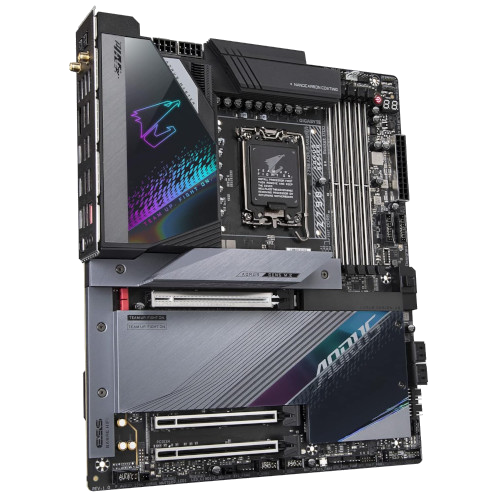
Gigabyte Z790 Aorus Master
An excellent array of features for $500
There's very little to dislike about the Gigabyte Z790 Aorus Master aside from the price. It's expensive, but you get a lot of features, including solid power delivery, excellent BIOS, and plenty of connections for all your components.
- Massive 20+1+2 stage VRM
- Five M.2 slots, one for PCIe 5.0 SSDs
- Great rear I/O that includes 10 gigabit Ethernet
- Overkill for most users
The Z790 chipset is essentially the Z690 chipset with just a few extra PCIe 4.0 lanes; it still uses the same LGA 1700 socket. Consequently, companies like Gigabyte have opted to refresh their existing Z690 motherboards, and the high-end Z790 Aorus Master is no exception. While last-generation Z690 motherboards are cheaper than their Z790 counterparts at the moment, you might as well go Z790 if you're planning on getting one of the highest-end boards available.
The Z790 Aorus Master has a relatively busy color scheme; its black PCB is dotted with silver electrical components and white text, while everything on top of the board itself is silver and black with a brushed, metallic finish. Part of the heatsink for M.2 SSDs is reflective and sports the Aorus logo, and the housing for the rear I/O has an RGB display on top. The design is clearly premium and gamery, though doesn't use the classic dark black plus RGB theme that's popular these days.
The Aorus Master is an EATX board, which is a larger form factor than ATX and requires a chassis with EATX support. Thankfully, Gigabyte makes good use of all this additional space; the Aorus Master has a 20+1+2 stage VRM, five M.2 slots (one of which supports PCIe 5.0 SSDs), support for DDR5-7600, and tons of features such as an error code display and headers for fans and I/O. Rear I/O is full of USB 3.2 ports and includes a 10-gigabit Intel Ethernet port, which is very rare to see on a consumer-grade board.
The Z790 Aorus Master can power an extremely high-end PC using a top-end Core i9-13900K while having all the I/O for basically anything you want. Its price tag of $450 (at least at the time of writing) is certainly high for a motherboard, but among the high-end segment, the Aorus Master is actually somewhat cheap. Very few motherboards from competing vendors offer everything the Aorus Master does.
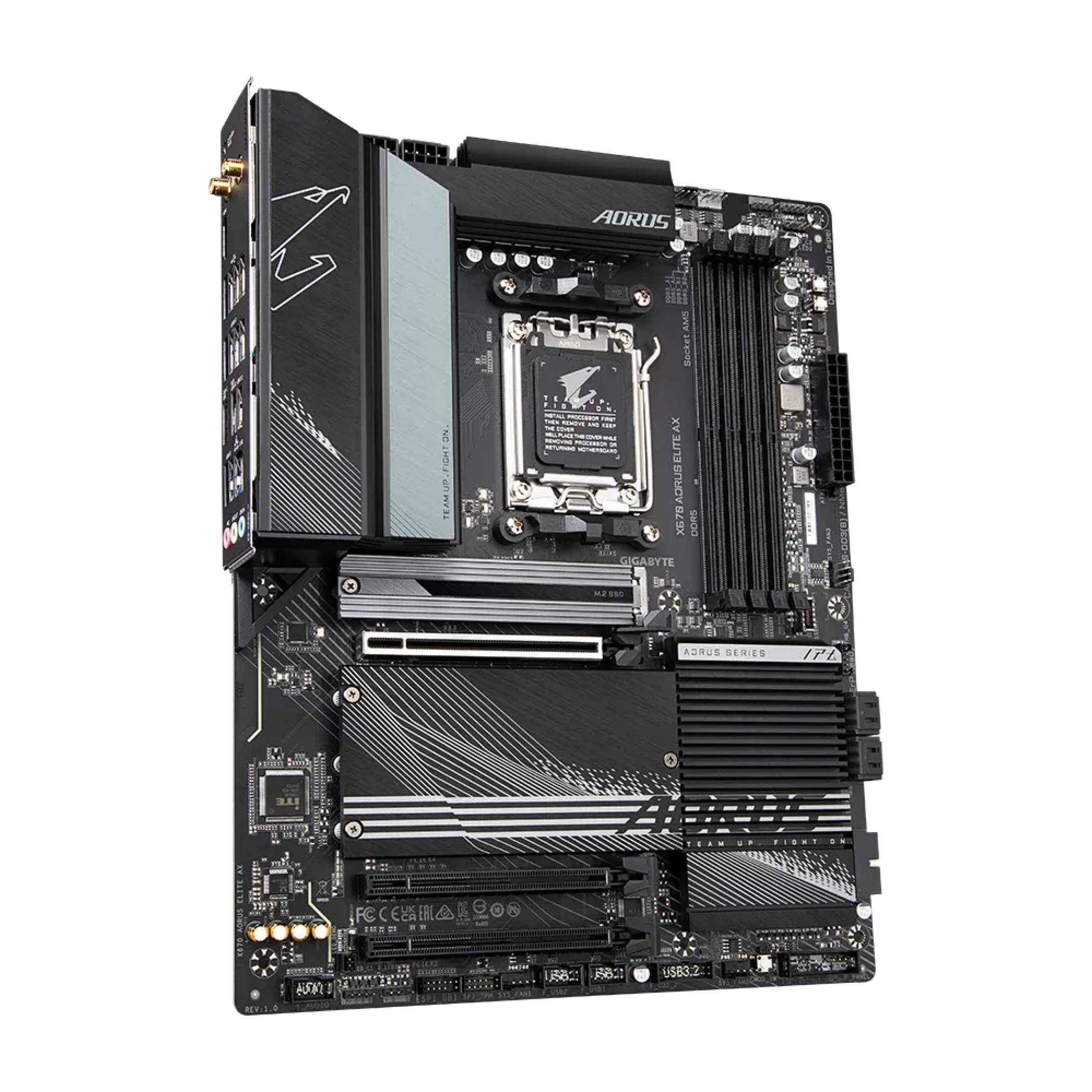
GIGABYTE X670 AORUS Elite AX
Great bang for buck at the high-end
The Gigabyte X670 Aorus Elite AX has the essentials for a high-end gaming PC, including support for DDR5-6666 memory, four M.2 slots for SSDs (one of which supports PCIe 5.0), and a 16-stage VRM.
- Big 16+2+2 stage VRM
- Four M.2 slots, with one at PCIe 5.0 speeds
- Super cheap for its features
- No PCIe 5.0 for GPUs
As you may know, AMD has two high-end chipsets for AM5 motherboards this generation: X670 and X670E. These chipsets are so similar that instead of recommending one X670 and one X670E Gigabyte motherboard, we will recommend Gigabyte's strongest motherboard among the X670 and X670E chipsets. The X670 Aorus Elite packs lots of features for a high-end Ryzen 7000 PC without costing as much as a similarly-specced top-end motherboard using the X670E chipset.
The X670 Aorus Elite primarily uses the color black with some minimalist, decorative white lines and accents across the I/O housing, PCB, and M.2 heatsink. All of the heatsinks (except for the one on the top M.2 slot) and the I/O housing have a brushed, metallic finish that is often found on premium motherboards. A part of the VRM heatsink and the top M.2 heatsink sport gray rather than black or white, but they actually fit in quite nicely with the rest of the motherboard. If you're the kind of person who doesn't like the common dark black with RGB aesthetic, the Aorus Elite is for you.
The X670 Aorus Elite uses a 16+2+2 stage VRM and has support for DDR5-6666, making it good to pair with even a Ryzen 9 7950X. It doesn't sacrifice much on other features either, as it has four M.2 slots (one of which runs at PCIe 5.0 speeds), Wi-Fi 6E, and 2.5 gigabit Ethernet, which is from Realtek and not Intel, unfortunately. PCIe 5.0 support for graphics is also missing, but since there are no PCIe 5.0 GPUs on the market yet, it doesn't really matter. The Aorus Elite also has nine USB 3.2 ports on the rear I/O, which should be more than enough for most users.
The price is where the X670 Aorus Elite stands out. At just under $300, this motherboard matches much more expensive X670E models where it counts, and also enjoys a slight edge against its competitors' motherboards in VRM size and DDR5 support. The X670 Aorus Elite is a good option for anyone that wants to build a higher-end Ryzen desktop on a reasonably sized budget.
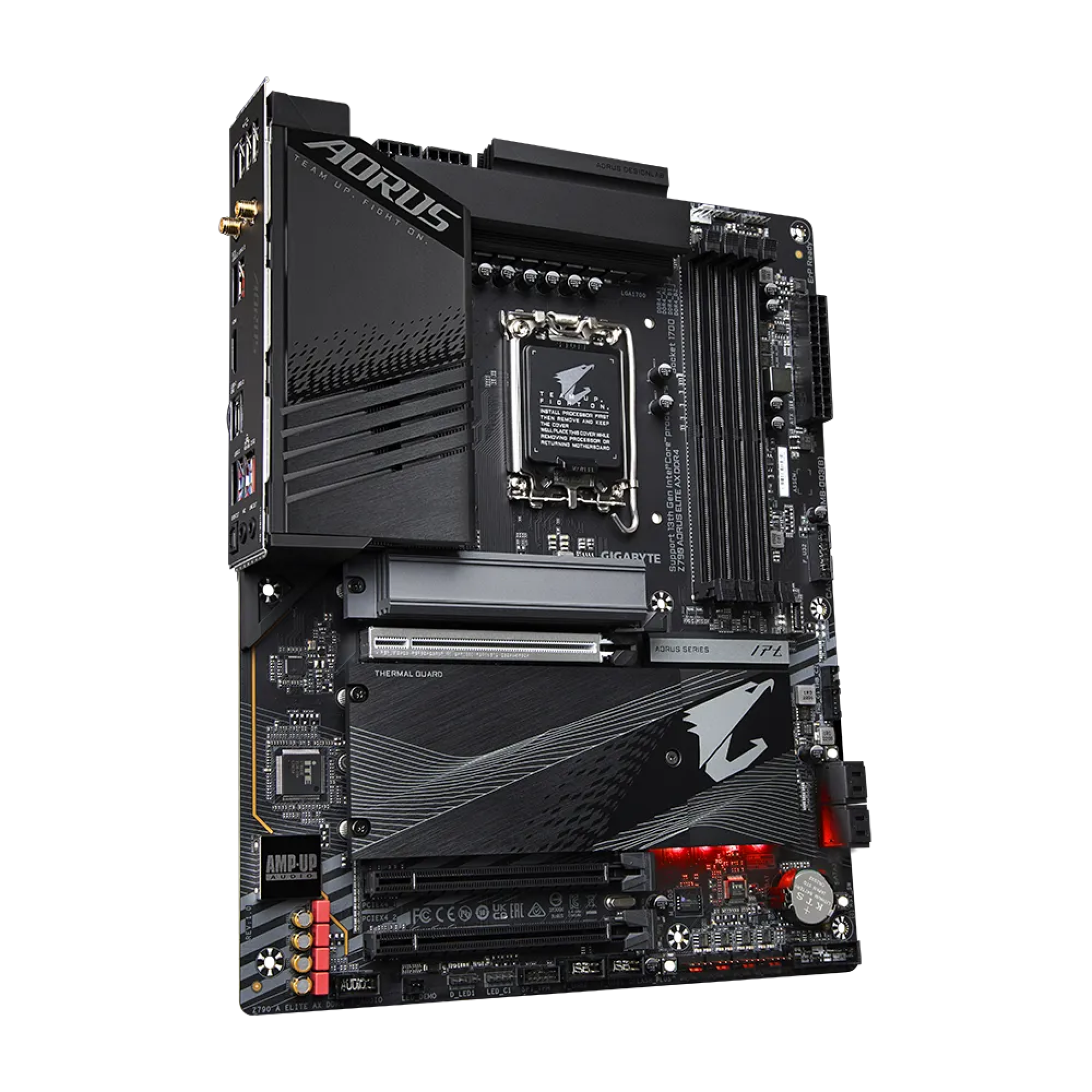
Gigabyte Z790 Aorus Elite AX DDR4
A high-end motherboard for a midrange price
Gigabyte's Z790 Aorus Elite AX DDR4 is a midrange LGA 1700 motherboard with unlocked overclocking, a 16+1+2 stage VRM, lots of USB ports, and four M.2 slots for PCIe 4.0 SSDs.
- Powerful 16+1+2 stage VRM
- Four M.2 slots
- Uses cheap DDR4
- Rear I/O is kind of disappointing
- Doesn't support PCIe 5.0 SSDs
While the Z790 chipset is the best that Intel offers, almost every motherboard maker has at least one option that's pretty cheap and priced more like a B760 or H770 board. Gigabyte's Z790 Aorus Elite DDR4 isn't just the company's best midrange motherboard for Intel chips; it's also one of the best options for Intel CPUs, period, thanks to its competitive price tag of roughly $250 and compelling features.
The Z790 Aorus Elite is solid in terms of visual quality, for starters. It uses Gigabyte's standard array of black with silver and gray accents with a little bit of RGB lighting. There's not too much flair with the heatsinks or the I/O housing as you'd normally get on an Asus or MSI motherboard, and if you prefer a more boxy appearance, then you'll like the Z790 Aorus Elite.
The feature set on the Z790 Aorus Elite is also good, coming with a 16+1+2 stage VRM that should be enough even for the Core i9-14900K without overclocking and four M.2 slots with PCIe 4.0 support. The board supports DDR4 memory instead of DDR5, which means a little less performance for a much lower price tag for memory. The rear I/O is decently equipped with 10 USB ports (six of which run at 3.2 speeds), 2.5 gigabit Ethernet, and Wi-Fi 6.
The Z790 Aorus Elite has been regularly going for about $250 or less for a while, making it one of the more competitively priced Z790 boards. It's great for both midrange and even high-end builds thanks to its low price and spread of features, and with the end of the LGA 1700 socket, it might even go on sale for less.
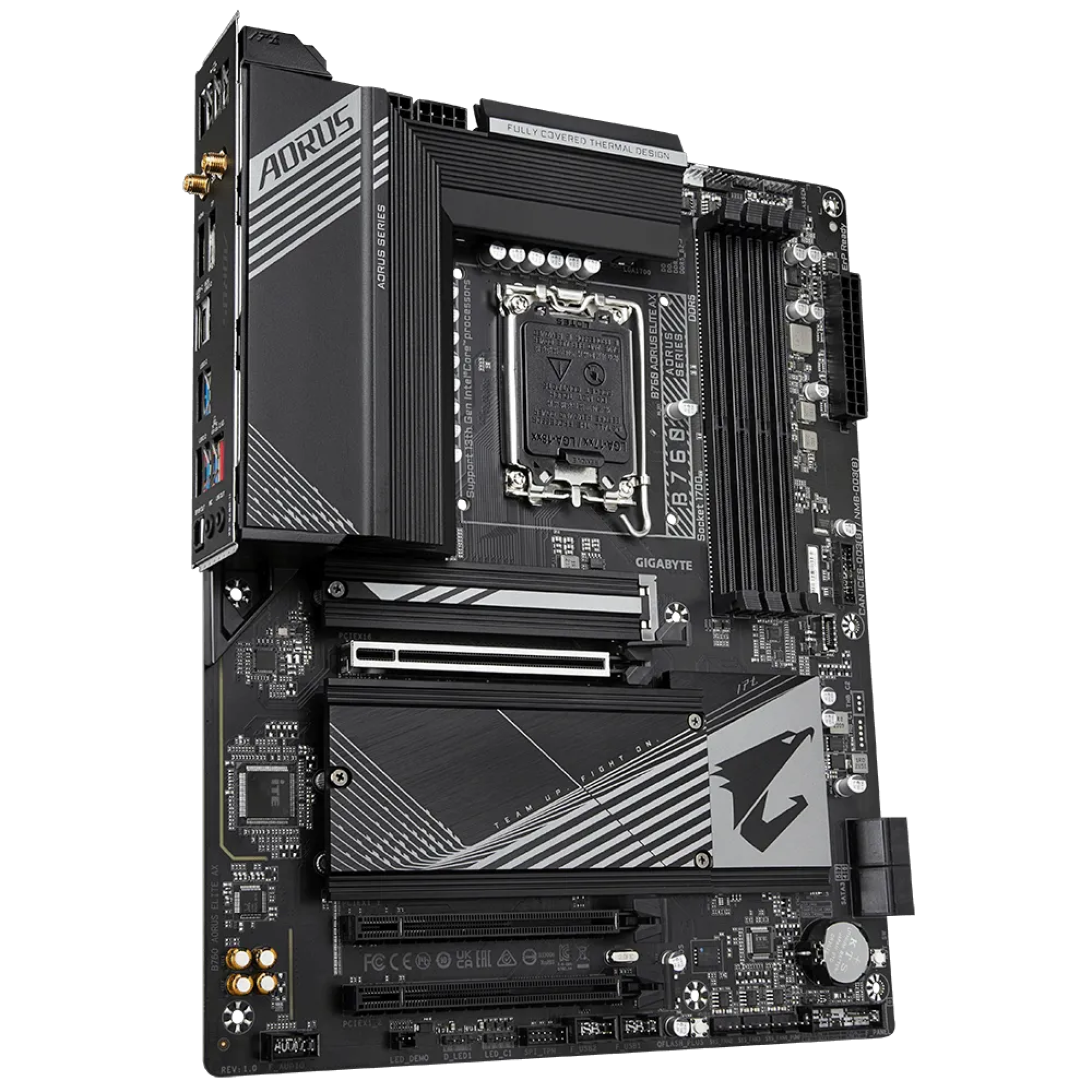
GIGABYTE B760 AORUS Elite AX
Though we would rather have a cheap B660 model instead
Gigabyte's B760 Aorus Elite is a midrange motherboard for lower power 12th- and 13th-generation Intel CPUs. Its 12+1+1 stage VRM limits it to non-K CPUs and higher-end Core i5, but it does have three M.2 slots and 2.5 gigabit Ethernet.
- Decent enough 12+1+1 stage VRM
- Three M.2 slots
- Cheap among B760 boards
- No PCIe 5.0
- No overclocking
Usually, we'd recommend a B660 motherboard here since the B760 chipset really isn't worth it, but Gigabyte doesn't really have any worthwhile B660 motherboards in stock. Unless you don't think you're ever going to upgrade your CPU, it's basically never worth settling for a cheap motherboard with a puny 8-stage or worse VRM. The next best thing from Gigabyte is its B760 Aorus Elite, a somewhat overpriced but good enough motherboard for 12th- and 13th-generation chips.
The B760 Aorus Elite is actually something of a downgrade from older B660 motherboards like the Aorus Master. Its 12+1+1 stage VRM is smaller, its three M.2 slots are fewer, and it uses DDR5 rather than DDR4, which drives the total price of the build upward. The I/O is fine enough though, with six USB 3.2 ports and four USB 2.0 ports, as well as 2.5 gigabit Ethernet (Realtek rather than Intel though).
If this board wasn't $180, it would get a more glowing recommendation here. The problem is that it's more expensive than a good B660 while having fewer features. The only reason we aren't recommending the B660 Aorus Master is because it's out of stock. It's a shame that a better version of this board isn't available anymore, but it is what it is.
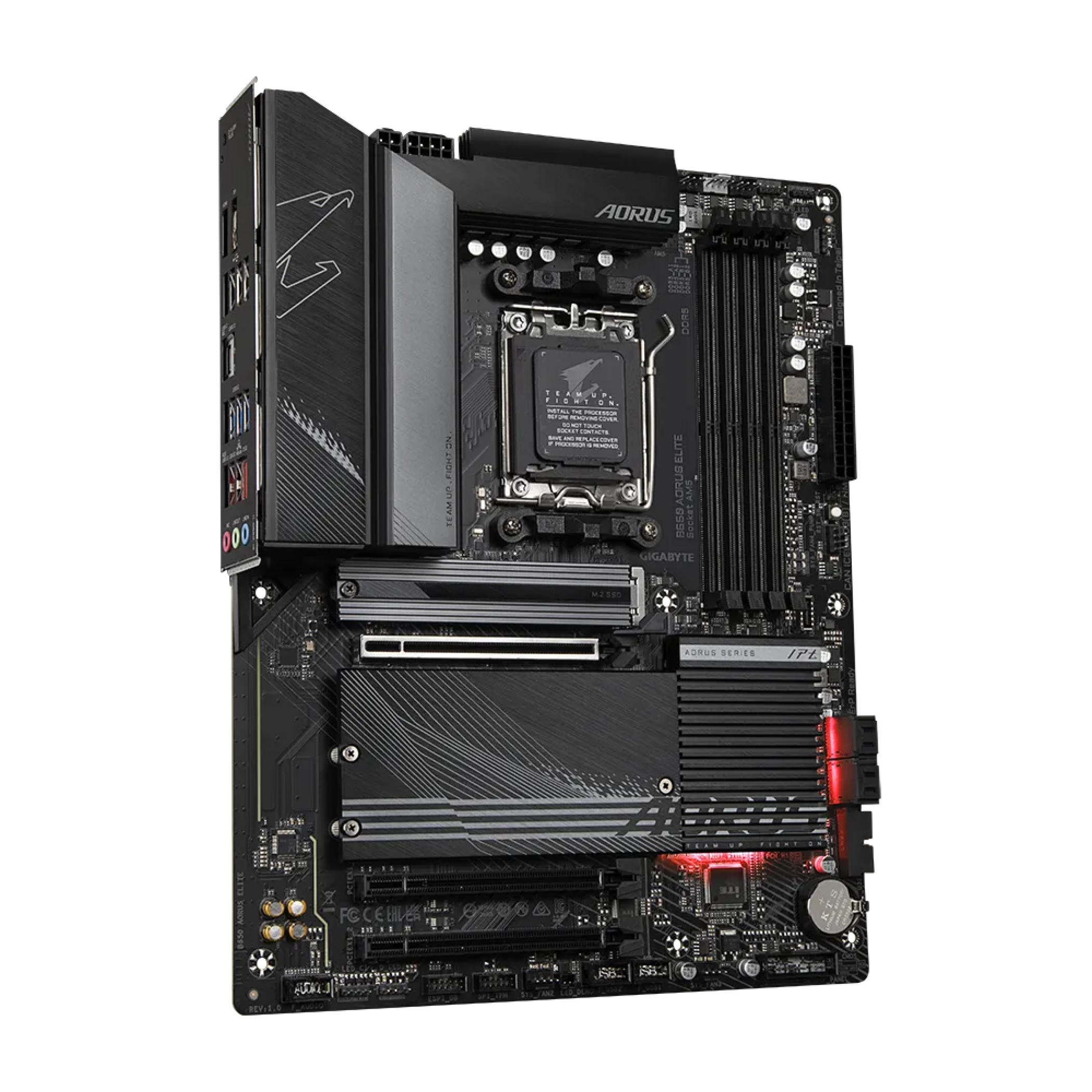
Gigabyte B650 Aorus Elite
A good choice for a midrange Ryzen build
The Gigabyte B650 Aorus Elite is a midrange AM5 motherboard with a 14+2 stage VRM, support for PCIe 5.0 SSDs, and an impressive assortment of rear I/O.
- Decent 14+2 stage VRM
- Support for PCIe 5.0 SSDs in one of its three M.2 slots
- Relatively good price
- Mediocre rear I/O
As you might guess from its name, Gigabyte's B650 Aorus Elite is essentially a slightly cut-down X670 Aorus Elite, with 90% of the features for significantly less. This is similar to the difference between Gigabyte's Z690 and B660 boards, but one important thing to note is that B650 motherboards have the same overclocking support as X670 motherboards, making the B650 Aorus Elite about as suitable for overclocking as its X670 counterpart.
The key features that the B650 version of the Aorus Elite gives up are some VRM stages (14+2+1 instead of 16+2+2) and a single M.2 slot, but otherwise very little else is compromised. The VRM is still sufficient for a Ryzen 9 7950X (at least at stock settings) and the three remaining M.2 slots still include one that has PCIe 5.0 support. If you use lots of USB devices, you might be disappointed that the B650 Aorus Elite has just eight USB 3.2 ports (plus four USB 2.0 ports). At least the 2.5 gigabit Realtek Ethernet is unchanged from the X670 model.
With a price tag of about $230, the B650 Aorus Elite is one of the more expensive B650 motherboards, but paying a little extra to get more VRMs and PCIe 5.0 support for SSDs is probably worth it if you plan on upgrading your PC in the future with higher-end components. You might also choose to spend an extra $50 or so to get the X670 version if you want more VRMs, an extra M.2 slot, and more USB ports.
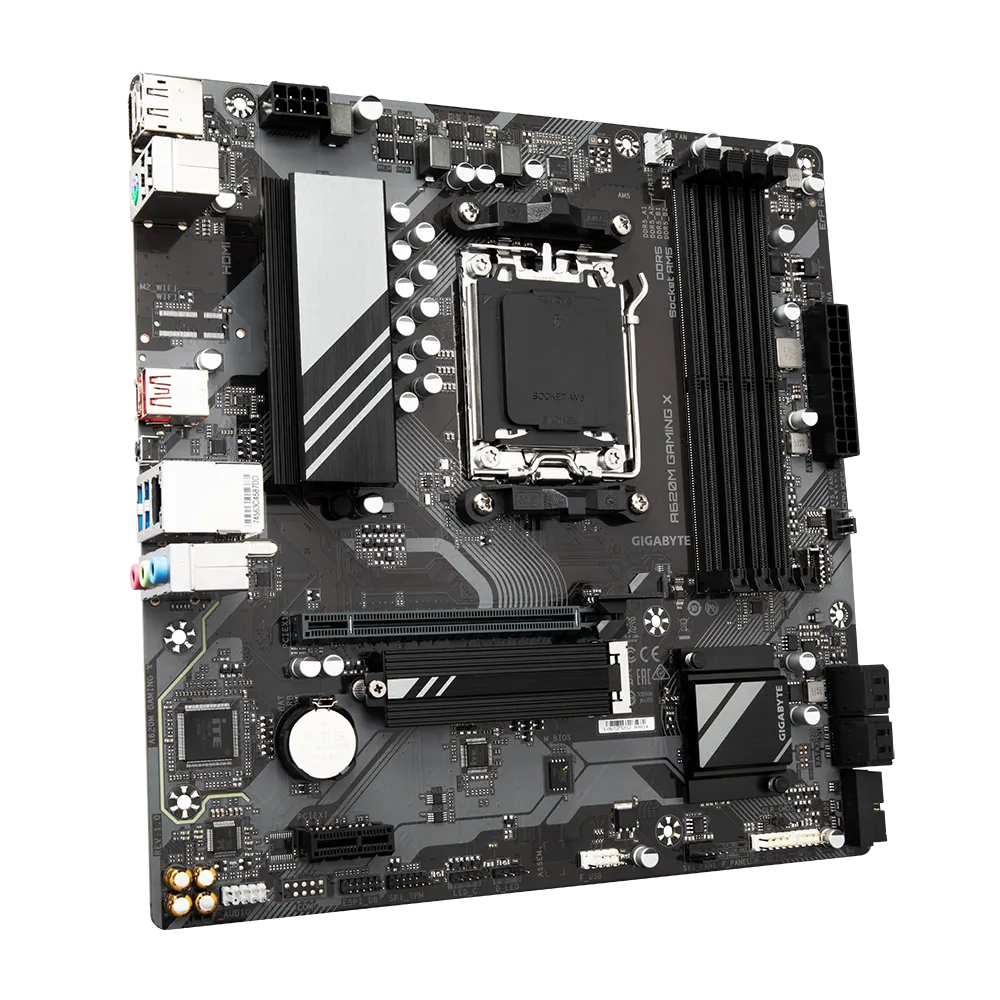
Gigabyte A620M Gaming X
One of the cheapest AM5 motherboards out there
Gigabyte's A620M Gaming X is a low-end AM5 motherboard that's ideal to pair with midrange Ryzen chips like the Ryzen 5 7600. It sports an 8+2+1 stage VRM, has four RAM slots, and has one M.2 slot with PCIe 4.0 support.
- Very cheap for AM5
- Four RAM slots
- Decent 8+2+1 phase VRM
- Just a single M.2 slot
- Paltry I/O ports
A620 is AMD's low-end chipset for the AM5 platform and it's made the Ryzen 7000 series much more accessible to people on a budget, albeit by stripping out lots of features. There aren't a ton of A620 boards out there so far, but of the two Gigabyte offers, its A620M Gaming X is not only the better one, it's also a decent motherboard in its own right, though not without significant drawbacks.
Let's start with the things this motherboard gets right. Firstly, it has an 8+2+1 stage VRM, which is firmly midrange and should give you plenty of room to start with something like a 7600 and upgrade to a 7900 or 7800X3D down the line. Second, it has four DDR5 slots, which offers more flexibility for what kind of RAM you can use. This is basically all you need for a decent gaming PC.
However, there are also two major issues on the A620M Gaming X that makes it difficult to support a PC you'd want to use in the long term. The fact that there's only one M.2 slot really limits your storage choices and basically forces you to get some SATA SSDs or HDDs if you want multiple storage devices. Also, the rear I/O is really bad and has just six USB ports (two of which are at 2.0 speeds), a gigabit Ethernet port, and three regular audio jacks. If you want to use this PC in the long term, there are going to be some significant hurdles.
While A620 motherboards like Gigabyte's A620M Gaming X lower the cost to build a Ryzen 7000 PC, they compromise on some pretty important things that will be annoying in the long run. It also doesn't change the fact that DDR5 memory is still really expensive compared to DDR4 and that AMD's cheapest Ryzen CPU is over $200. I would recommend waiting for a Ryzen 3 chip before buying this motherboard if you want a balanced build.
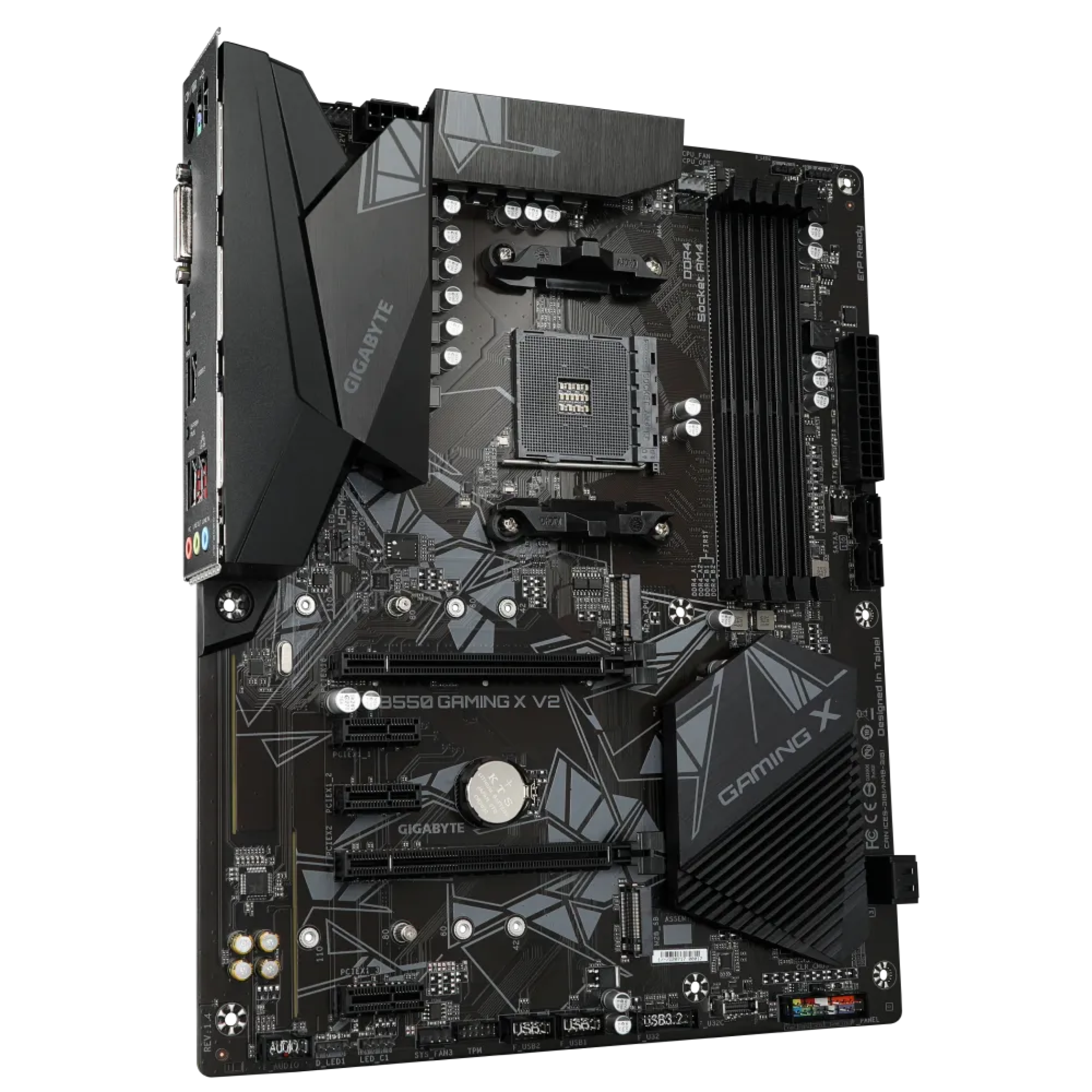
Gigabyte B550 Gaming X V2
Great for powering a cheap Ryzen 5000 build
The Gigabyte B550 Gaming X V2 motherboard is a lower-end AM4 board with the bare essentials to power a midrange PC. It has a 10+3 stage VRM and support for PCIe 4.0 SSDs.
- Support for PCIe 4.0 SSDs
- Cheap
- Mediocre 10+3 phase VRM
- Terrible rear I/O
It's getting hard to find good B550 boards at an acceptable price, and that's especially true of Gigabyte. Additionally, sub-$200 X570 motherboards make it hard to justify buying some of the higher-end B550 motherboards since they're barely any cheaper and have a noticeable amount of cut features. There's really only one B550 motherboard from Gigabyte that's worth buying, and it's the B550 Gaming X V2.
The B550 Gaming X V2 is fine for midrange Ryzen 5 and Ryzen 7 CPUs but might struggle a bit with higher-end Ryzen 9 chips since it only has a 10+3 stage VRM and DDR4 memory support caps out at 4733MHz. There are only two M.2 slots, but thankfully, one of them supports PCIe 4.0 SSDs. Perhaps the biggest downer on the B550 Gaming X V2 is the rear I/O: there are just four USB 3.2 ports, two USB 2.0 ports, and a gigabit Realtek Ethernet port. The connectivity on this board is downright paltry.
What makes up for all this is the price. At $120, it's significantly cheaper than higher-end B550 and X570 motherboards to the point where it makes sense to buy. I'm not saying Gigabyte's B550 Gaming X V2 is a great deal simply because higher-end boards like the B550 Aorus Elite are expensive, but it justifies its existence well enough and could be great for the kind of builder who needs something that is cheap and has just enough horsepower to keep on going for years.
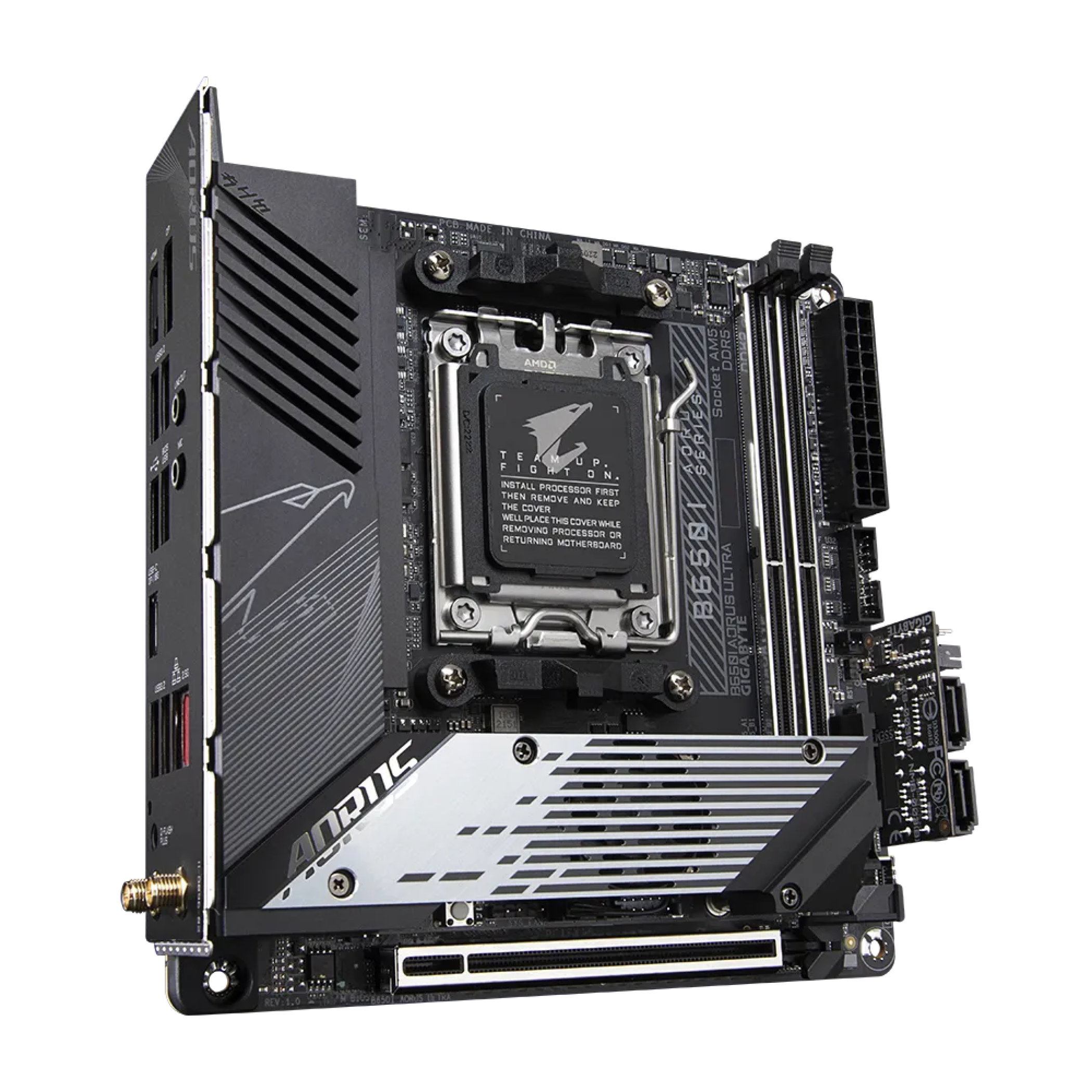
Gigabyte B650I Aorus Ultra
Ideal for midrange ITX PCs
The Gigabyte B650I Aorus Ultra is an AM5 mini-ITX motherboard that's ideal for PCs running midrange Ryzen 7000 chips; it comes with an 8+2+1 stage VRM and a PCIe 5.0 slot for NVMe SSDs.
If you're building a mini-ITX PC today, you're probably going to have limited CPU cooling potential and you'll definitely have a limited amount of VRMs on whatever motherboard you choose, meaning power efficiency is king. Unfortunately, this basically puts Intel chips out of the running since they're so inefficient, and you'll want an AM5 motherboard instead, like Gigabyte's B650I Aorus Ultra. This is a more midrange ITX board that goes for around $260, and it's a great match for non-X Ryzen 7000 CPUs.
With just an 8+2+1 stage VRM, you're not really going to be able to use an X-class CPU (especially not the 7900X(3D) or 7950X(3D)), but low power chips like the 7600, 7700, 7900 and 7800X3D are all viable choices. The B650I Aorus Ultra has a PCIe 5.0 M.2 slot on the front under a large heatsink, and an extra PCIe 4.0 slot is available on the back, which is about the max amount of M.2 slots for ITX.. For a cheaper ITX board, the rear I/O is actually pretty decent, featuring seven USB ports (five of which are version 3.2), 2.5 gigabit Ethernet, and WiFi 6.
The B650I Aorus Ultra isn't going to power your super high-end ITX gaming PC, but it'll get you to midrange or regular high-end for a good price. That it supports PCIe 5.0 SSDs is pretty nice, and it's not a given for B650 motherboards. Overall, this board is actually not that much worse than the higher-end ROG Strix B650E-I from Asus, which is over $300, and it's both cheaper and better than MSI's MPG B650I Edge board too.
Best Gigabyte motherboards you can buy in 2023: Final Thoughts
Gigabyte divides its attention evenly between every segment of the motherboard market, which means it's easy to find well-priced Gigabyte motherboards for pretty much every chipset. The top-end Z790 Aorus Master is worth pairing with a powerful Intel CPU like the Core i9-13900K, though the cheaper Z790 Aorus Elite DDR4 also has a place.

Gigabyte Z790 Aorus Master
There's very little to dislike about the Gigabyte Z790 Aorus Master aside from the price. It's expensive, but you get a lot of features, including solid power delivery, excellent BIOS, and plenty of connections for all your components.
For AMD users, the X670 Aorus Elite has the features you'd want in a high-end Ryzen PC without the frills that jack up the price. The even cheaper B650 Aorus Elite is a good alternative for budget buyers who want to get into Ryzen 7000 for a lower price while retaining important features like M.2 slots and VRM stages.

GIGABYTE X670 AORUS Elite AX
The Gigabyte X670 Aorus Elite AX has the essentials for a high-end gaming PC, including support for DDR5-6666 memory, four M.2 slots for SSDs (one of which supports PCIe 5.0), and a 16-stage VRM.
Depending on your processor of choice, you can also check out our dedicated collections of the best motherboards for Intel chips or the best motherboards for AMD chips. These collections have some really good options and they'll save you a lot of time combing through each unit. We also encourage you to join our XDA Computing Forums to have discussions and get more product recommendations from our community members.
